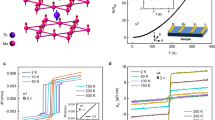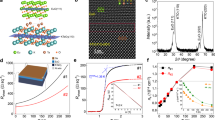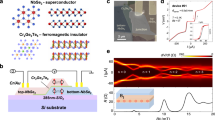Abstract
The intimate connection between magnetism and superconducting pairing plays a central role in determining the occurrence of unconventional superconducting states. In particular, magnetism can cause a modulation of superconducting pairing in real space in both copper-based and iron-based materials. Exploring this effect can shed light on the mechanism of unconventional superconductivity. Here we report on the discovery of a spatially varying superconducting state residing at the interface between KTaO3 and ferromagnetic EuO. Electrical transport measurements reveal different values of the critical temperature and magnetic field at which the superconductivity breaks down when current is applied along the two orthogonal in-plane directions. This anisotropy occurs in low-carrier-density samples that are characterized by strong coupling between the Ta 5d and Eu 4f electrons, whereas in high-carrier-density samples, the coupling is weakened and the superconducting properties become isotropic. Our observations imply the emergence of superconducting stripes where phase coherence is established ahead of the rest of the interface, arising from a band-filling-dependent ferromagnetic proximity.
This is a preview of subscription content, access via your institution
Access options
Access Nature and 54 other Nature Portfolio journals
Get Nature+, our best-value online-access subscription
$29.99 / 30 days
cancel any time
Subscribe to this journal
Receive 12 print issues and online access
$209.00 per year
only $17.42 per issue
Buy this article
- Purchase on Springer Link
- Instant access to full article PDF
Prices may be subject to local taxes which are calculated during checkout




Similar content being viewed by others
Data availability
The data that support the findings of this study are available from the corresponding authors upon reasonable request. Source data are provided with this paper.
Code availability
The codes for analysing the data of this study are available from the corresponding authors upon request.
References
Tranquada, J. M., Sternlleb, B. J., Axe, J. D., Nakamura, Y. & Uchida, S. Evidence for stripe correlations of spins and holes in copper oxide superconductors. Nature 375, 561–563 (1995).
Emery, V. J., Kivelson, S. A. & Tranquada, J. M. Stripe phases in high-temperature superconductors. Proc. Natl Acad. Sci. USA 96, 8814–8817 (1999).
Zaanen, J. & Oleś, A. M. Striped phase in the cuprates as a semiclassical phenomenon. Ann. Phys. 5, 224–246 (1996).
Tranquada, J. M. Cuprate superconductors as viewed through a striped lens. Adv. Phys. 69, 437–509 (2020).
Emery, V. J., Kivelson, S. A. & Lin, H. Q. Phase separation in the t-J model. Phys. Rev. Lett. 64, 475–478 (1990).
Emery, V. J., Kivelson, S. A. & Zachar, O. Spin-gap proximity effect mechanism of high-temperature superconductivity. Phys. Rev. B 56, 6120–6147 (1997).
Li, Q., Hücker, M., Gu, G. D., Tsvelik, A. M. & Tranquada, J. M. Two-dimensional superconducting fluctuations in stripe-ordered La1.875Ba0.125CuO4. Phys. Rev. Lett. 99, 067001 (2007).
Li, Y. et al. Tuning from failed superconductor to failed insulator with magnetic field. Sci. Adv. 5, eaav7686 (2019).
Himeda, A., Kato, T. & Ogata, M. Stripe states with spatially oscillating d-wave superconductivity in the two-dimensional t−t′−J model. Phys. Rev. Lett. 88, 117001 (2002).
Wollny, A. & Vojta, M. Interlayer Josephson coupling in stripe-ordered superconducting cuprates. Phys. Rev. B 80, 132504 (2009).
Berg, E. et al. Dynamical layer decoupling in a stripe-ordered high-Tc superconductor. Phys. Rev. Lett. 99, 127003 (2007).
Agterberg, D. F. et al. The physics of pair-density waves: cuprate superconductors and beyond. Annu. Rev. Condens. Matter Phys. 11, 231–270 (2020).
Berg, E., Fradkin, E., Kivelson, S. A. & Tranquada, J. M. Striped superconductors: how spin, charge and superconducting orders intertwine in the cuprates. New J. Phys. 11, 115004 (2009).
Zhao, H. et al. Smectic pair-density-wave order in EuRbFe4As4. Nature 618, 940–945 (2023).
Fulde, P. & Ferrell, R. A. Superconductivity in a strong spin-exchange field. Phys. Rev. 135, A550 (1964).
Takada, S. & Izuyama, T. Superconductivity in a molecular field. I. Prog. Theor. Phys. 41, 635–663 (1969).
Bergeret, F. S., Volkov, A. F. & Efetov, K. B. Odd triplet superconductivity and related phenomena in superconductor-ferromagnet structures. Rev. Mod. Phys. 77, 1321–1373 (2005).
Fradkin, E., Kivelson, S. A. & Tranquada, J. M. Colloquium: theory of intertwined orders in high temperature superconductors. Rev. Mod. Phys. 87, 457–482 (2015).
Liu, C. et al. Two-dimensional superconductivity and anisotropic transport at KTaO3 (111) interfaces. Science 371, 716–721 (2021).
Tinkham, M. Introduction to Superconductivity (Dover Publications, 2004).
Hua, X. et al. Tunable two-dimensional superconductivity and spin-orbit coupling at the EuO/KTaO3 (110) interface. npj Quantum Mater. 7, 97 (2022).
Kim, M., Kozuka, Y., Bell, C., Hikita, Y. & Hwang, H. Y. Intrinsic spin-orbit coupling in superconducting δ-doped SrTiO3 heterostructures. Phys. Rev. B 86, 085121 (2012).
Shalom, M. B. et al. Tuning spin-orbit coupling and superconductivity at the SrTiO3/LaAlO3 interface: a magnetotransport study. Phys. Rev. Lett. 104, 126802 (2010).
Monteiro, A. M. R. V. L. et al. Two-dimensional superconductivity at the (111)LaAlO3/SrTiO3 interface. Phys. Rev. B 96, 020504(R) (2017).
Maki, K. Effect of Pauli paramagnetism on magnetic properties of high-field superconductors. Phys. Rev. 148, 362–369 (1966).
Klemm, R. A., Luther, A. & Beasley, M. R. Theory of the upper critical field in layered superconductors. Phys. Rev. B 12, 877–891 (1975).
Gurevich, A. Enhancement of the upper critical field by nonmagnetic impurities in dirty two-gap superconductors. Phys. Rev. B 67, 184515 (2003).
Balakirev, F. F. et al. Anisotropy reversal of the upper critical field at low temperatures and spin-locked superconductivity in K2Cr3As3. Phys. Rev. B 91, 220505(R) (2015).
Bert, J. A. et al. Direct imaging of the coexistence of ferromagnetism and superconductivity at the LaAlO3/SrTiO3 interface. Nat. Phys. 7, 767–771 (2011).
Nakajima, H., Nomura, K. & Sambongi, T. Anisotropic superconducting transition in ZrTe3. Phys. B 143, 240–242 (1986).
Yamaya, K., Takayanagi, S. & Tanda, S. Mixed bulk-filament nature in superconductivity of the charge-density-wave conductor ZrTe3. Phys. Rev. B 85, 184513 (2012).
Michaeli, K., Potter, A. C. & Lee, P. A. Superconducting and ferromagnetic phases in SrTiO3/LaAlO3 oxide interface structures: possibility of finite momentum pairing. Phys. Rev. Lett. 108, 117003 (2012).
Eastman, D. E., Holtzberg, F. & Methfessel, S. Photoemission studies of the electronic structure of EuO, EuS, EuSe, and GdS. Phys. Rev. Lett. 23, 226 (1969).
Modak, B. & Ghosh, S. K. An efficient strategy for controlled band gap engineering of KTaO3. J. Phys. Chem. C 120, 6920–6929 (2016).
Hayes, I. M. et al. Multicomponent superconducting order parameter in UTe2. Science 373, 797–801 (2021).
Bierwagen, O. et al. Mobility and carrier density in materials with anisotropic conductivity revealed by van der Pauw measurements. Phys. Rev. B. 70, 165307 (2004).
Vaglio, R. et al. Explanation of the resistance-peak anomaly in nonhomogeneous superconductors. Phys. Rev. B. 47, 15302–15303 (1993).
Bardeen, J. Critical fields and currents in superconductors. Rev. Mod. Phys. 34, 667–681 (1962).
Kunchur, M. N. Current-induced pair breaking in magnesium diboride. J. Phys. Condens. Matter 16, R1183–R1204 (2004).
Genenko, Y. A. Magnetic self-field entry into a current-carrying type-II superconductor. Phys. Rev. B. 49, 6950–6957 (1994).
Hunte, F. et al. Two-band superconductivity in LaFeAsO0.89F0.11 at very high magnetic fields. Nature 453, 903–905 (2008).
Pan, Y. P. et al. 3D nano-bridge-based SQUID susceptometers for scanning magnetic imaging of quantum materials. Nanotechnology 30, 305303 (2019).
Pan, Y. P. et al. Improving spatial resolution of scanning SQUID microscopy with an on-chip design. Supercond. Sci. Technol. 34, 115011 (2021).
Kresse, G. & Furthmiiller, J. Efficiency of ab-initio total energy calculations for metals and semiconductors using a plane-wave basis set. Comput. Mater. Sci. 6, 15–50 (1996).
Kresse, G. & Joubert, D. From ultrasoft pseudopotentials to the projector augmented-wave method. Phys. Rev. B. 59, 1758–1775 (1999).
Perdew, J. & Zunger, A. Self-interaction correction to density-functional approximations for many-electron systems. Phys. Rev. B. 23, 5048–5079 (1981).
An, J. M. & Belashchenko, K. D. Electronic structure and magnetic properties of Gd-doped and Eu-rich EuO. Phys. Rev. B 88, 054421 (2013).
Wang, Z. et al. Anisotropic two-dimensional electron gas at SrTiO3(110). Proc. Natl Acad. Sci. USA 111, 3933–3937 (2014).
Lebedev, N. et al. Inhomogeneous superconductivity and quasilinear magnetoresistance at amorphous LaTiO3/SrTiO3 interfaces. J. Phys. Condens. Matter 33, 055001 (2020).
Hameed, S. et al. Enhanced superconductivity and ferroelectric quantum criticality in plastically deformed strontium titanate. Nat. Mater. 21, 54–61 (2022).
Acknowledgements
We thank Z. Wang, W. Hu and J. Ying for valuable discussions. This work was supported by the National Key Research and Development Program of China (grant nos. 2022YFA1602601 (to X.C. and T.W.), 2022YFA1602602 (to Z.X. and Z. Wang) and 2021YFA1400100 (to Yihua Wang)), the National Natural Science Foundation of China (grant nos. 11888101 (to X.C.), 12274390 (to Z.X.), 12374062 (to Z. Liu), 92365201 (to Z. Liu), 12150003 (to Yihua Wang) and 11827805 (to Yihua Wang)), Anhui Initiative in Quantum Information Technologies (AHY160000 (to X.C.)), Basic Research Program of the Chinese Academy of Sciences Based on Major Scientific Infrastructures (no. JZHKYPT-2021-08 (to X.C., Z.X., T.W. and Z. Wang)), the Innovation Program for Quantum Science and Technology (2021ZD0302802 (to X.C.)) and the Shanghai Municipal Science and Technology Major Project (grant no. 2019SHZDZX01 (to Yihua Wang)).
Author information
Authors and Affiliations
Contributions
X.H. and X.C. conceived the research project. X.H., Z.X. and X.C. designed the experiments. X.H., F.M., Z.H. and Z. Li prepared the samples. X.H. and Z.H. performed the transport measurements. Z.Z., X.L., Z. Liu and Z. Weng performed the first-principles calculations. H.Y., Youfang Wang and Yihua Wang performed the scanning SQUID measurements. X.H., Yihua Wang, Z.X. and X.C. analysed the data with help from Z. Wang, T.W. and Z. Liu. X.H., Yihua Wang, Z. Liu, Z.X. and X.C. wrote the paper with inputs from all authors.
Corresponding authors
Ethics declarations
Competing interests
The authors declare no competing interests.
Peer review
Peer review information
Nature Physics thanks the anonymous reviewers for their contribution to the peer review of this work.
Additional information
Publisher’s note Springer Nature remains neutral with regard to jurisdictional claims in published maps and institutional affiliations.
Extended data
Extended Data Fig. 1 θ-2θ X-ray diffraction (XRD) patterns and atomic force microscope (AFM) images of the EuO films grown on the KTO (110) substrates.
XRD patterns of samples with a, ns(3 K) = 9.6 × 1013 cm−2 and b, ns(3 K) = 6.8 × 1013 cm−2 specifying the well-orientated EuO (111) films on KTO (110). The size in AFM images is 5 × 5 μm2. The films are very flat with a root-mean-squared roughness (Rq) of 0.28 nm [c, for ns(3 K) = 9.6 × 1013 cm−2] and 0.53 nm [d, for ns(3 K) = 6.8 × 1013 cm−2].
Extended Data Fig. 2 Van der Pauw measurements in samples with different ns.
T-dependence of the normalized Rsheet [Rsheet(T)/Rsheet(3 K)] measured on the 2DEGs at EuO/KTO interfaces with different ns (measured at 3 K): a, ns = 9.4 × 1013 cm−2, b, ns = 9.0 × 1013 cm−2, c, ns = 8.6 × 1013 cm−2, d, ns = 8.5 × 1013 cm−2, e, ns = 7.8 × 1013 cm−2, f, ns = 7.7 × 1013 cm−2, g, ns = 7.2 × 1013 cm−2 and h, ns = 6.6 × 1013 cm−2. Rsheet is measured using the VDP method. For the black (red) curves, the current is applied along the [001] (\([1\bar{1}0]\)) directions.
Extended Data Fig. 3 Band-filling-dependence of the directional superconductivity.
The zero-resistance temperature \({T\,}_{{\rm{c}}}^{{\rm{zero}}}\) is plotted as a function of the interface carrier density ns (corresponding resistivity data are shown in Extended Data Fig. 2). Black squares (red circles) are \({T\,}_{{\rm{c}}}^{{\rm{zero}}}\) measured with current applied along the [001] (\([1\bar{1}0]\)) direction. An isotropic \({T}_{{\rm{c}}}^{{\rm{zero}}}\) can be observed in the samples with ns higher than about 8 × 1013 cm−2 (orange shaded region), while anisotropic \({T\,}_{{\rm{c}}}^{{\rm{zero}}}\) with remarkable difference between the two current directions appears in the samples with ns lower than approximately 8 × 1013 cm−2 (cyan shaded region).
Extended Data Fig. 4 Magnetic anisotropy of the EuO overlayer.
a, T-dependent magnetization of the EuO/KTO (110) heterostructure measured in the field-cooling mode with an applied field of H = 0.05 T in-plane. b, H-dependent magnetizations measured at T = 5 K with in-plane (blue) and out-of-plane (red) magnetic fields, respectively. c, Magnified view of the in-plane magnetization (blue curve in b) showing the hysteresis loop. The behaviour of magnetization suggests the in-plane easy direction for the Eu moments. d, Out-of-plane MR of samples with different ns. Data are measured in an out-of-plane magnetic field (H || [110]) at T = 2 K. No hysteresis loop can be seen in any of the samples, corroborating the in-plane easy direction for the magnetization of Eu local moments in the EuO overlayer.
Extended Data Fig. 5 Transport properties of high-ns and low-ns samples measured using VDP method.
a, c, T-dependent Rsheet measured from 50 mK to 3 K. b, d, MR measured in an out-of-plane magnetic field (H || [110]) at T = 0.1 K. Black and red colors represent current directions I || [001] and I || \([1\bar{1}0]\), respectively. To be noted, the superconducting transition shows no dependence on the direction of I in high-ns sample. The anomalous hump above Tc in Extended Data Figs. 2e–h and 5c (most evident for I || \([1\bar{1}0]\)) originates from the geometrical effect of the VDP configuration (see Methods).
Extended Data Fig. 6 Normalized MR measured in samples with different ns (3 K).
a–h, Data were taken under an out-of-plane magnetic field (H || [110]) at T = 0.1 K using the VDP method. Black and red colors represent current directions I || [001] and I || \([1\bar{1}0]\), respectively. The emergence and absence of the Tc anisotropy are consistent with the results shown in Extended Data Fig. 2.
Extended Data Fig. 7 Verification of the macroscopic sample homogeneity.
Superconducting transition temperatures measured in two Hall-bar devices fabricated on the same sample (a, high-ns; b, low-ns). The anisotropy can be observed for both devices on the low-ns interface but is absent in both devices on the high-ns sample. Sheet resistance plotted against T for two low-ns 2DEGs with c, ns(3 K) = 7.2 × 1013 cm−2 and d, 6.6 × 1013 cm−2, both measured using the VDP method. The four arrows in the insets represent the directions of current flows. The samples exhibit consistent behaviour for both I || [001] (black and red) and I || \([1\bar{1}0]\) (blue and green) with no indication of spatial inhomogeneity.
Extended Data Fig. 8 I-V curves of low-ns samples.
a, I-V curves measured at 0.2 K using the VDP method. The experimental data measured using the VDP method presented in the manuscript were taken under an application current of 0.5 μA, which is much smaller than the critical current Ic ~ 60–100 μA. b, c, I-V curves of two Hall-bar devices measured at 0.2 K. In the manuscript, the current applied in the Hall bar-method experiments is 0.05 μA, which is also much smaller than Ic ~ 4–8 μA.
Extended Data Fig. 9 Photograph showing scanned areas in the scanning SQUID experiment and magnetometry images of EuO magnetic domains.
a, Optical image of an area on the Hall-bar device 1, which was fabricated on a low-ns sample [ns(3 K) = 6.8 × 1013 cm−2]. Two zones (1 and 2, two well-separated regions with an identical area of 50 × 80 μm2) in this area were chosen for performing the scanning SQUID measurements in Fig. 3. Magnetic domains measured by magnetometry scan in b, c, zone 1 and d, e, zone 3 are characterized by randomly distributed patches with irregular shapes. The overall patterns show unremarkable T dependence below 700 mK.
Extended Data Fig. 10 Band structures.
Band structures obtained from a, the simple tight-binding Hamiltonian of Ta 5d orbitals of KTO (110) surface and b, DFT calculations of a (KTaO3)5-(EuO)14 supercell as shown in Supplementary Fig. 2 (see Methods for details). c–f, Orbital projection of the DFT bands. The blue and red color denote two spin components.
Supplementary information
Supplementary Information
Supplementary Figs. 1–5.
Source data
Source Data Fig. 1
Data regarding the transport measurements.
Source Data Fig. 2
Data regarding the upper critical fields.
Source Data Fig. 3
Data regarding the temperature dependence of susceptibility.
Source Data Fig. 4
Data regarding the magnetotransport measurements and theoretical calculations.
Source Data Extended Data Fig./Table 1
X-ray diffraction data.
Source Data Extended Data Fig./Table 2
Data regarding the temperature dependence of normalized Rsheet.
Source Data Extended Data Fig./Table 3
Data regarding the carrier density dependence of zero-resistance temperature.
Source Data Extended Data Fig./Table 4
Data regarding the magnetic measurements.
Source Data Extended Data Fig./Table 5
Data regarding the transport measurements.
Source Data Extended Data Fig./Table 6
Normalized MR data.
Source Data Extended Data Fig./Table 7
Data regarding the transport measurements with different measurement configurations.
Source Data Extended Data Fig./Table 8
Data regarding the current–voltage curves.
Source Data Extended Data Fig./Table 10
DFT calculation data.
Rights and permissions
Springer Nature or its licensor (e.g. a society or other partner) holds exclusive rights to this article under a publishing agreement with the author(s) or other rightsholder(s); author self-archiving of the accepted manuscript version of this article is solely governed by the terms of such publishing agreement and applicable law.
About this article
Cite this article
Hua, X., Zeng, Z., Meng, F. et al. Superconducting stripes induced by ferromagnetic proximity in an oxide heterostructure. Nat. Phys. (2024). https://doi.org/10.1038/s41567-024-02443-x
Received:
Accepted:
Published:
DOI: https://doi.org/10.1038/s41567-024-02443-x



